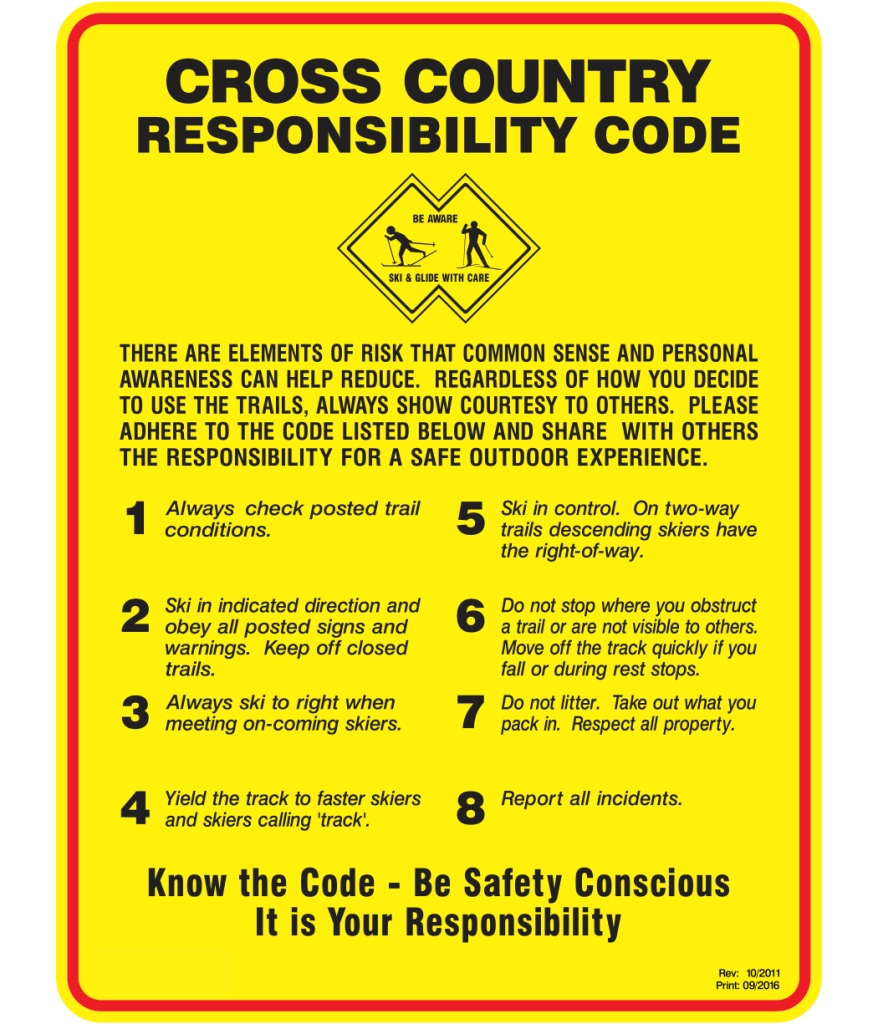

Understanding how to ski responsibly will help you to stay safe and enjoy a lifetime on the trails. As with all physical activities, there is risk of injury in cross-country skiing. Please take the time to review the safety information below. Parents and guardians of young skiers are encouraged to review safety practices during your ski time together.
Cross-Country Responsibility Code
There are elements of risk that common sense and personal awareness can help reduce. Regardless of how you decide to use the trails, always show courtesy to others. Please adhere to the code listed below and share with others the responsibility for a safe outdoor experience.
1. Always check posted trail conditions
2. Ski in indicated direction and obey all posted signs and warnings. Keep off closed trails.
3. Always ski to right when meeting on-coming skiers.
4. Yield the track to faster skiers and skiers calling ‘track’.
5. Ski in control. On two-way trails descending skiers have the right-of-way
6. Do not stop where you obstruct a trail or are not visible to others. Move off the track quickly if you fall or during rest stops.
7. Do not litter. Take out what you pack in. Respect all property.
8. Report incidents.
Know the code – Be Safety Conscious
It is Your Responsibility

Trail Etiquette
Many groomed trails in Nova Scotia are located in parks and golf courses – areas that welcome skiers, walkers, snowshoers, pets, and fat tire biking. Following a few general guidelines can help extend the life of the groomed surface, and maximize enjoyment for all users.
1. Ensure the trail can support your weight. If your skis, boot prints, or bike are leaving ruts or sinking, it is best to stay off the trails! Repairing ruts consumes hours of volunteer grooming efforts.
2. Avoid using trails during thawing conditions. Warmer temperatures mean the snow cannot hold its structure or shape, and may be unable to support your weight. During freeze-thaw cycles, try using the trails early morning while the snow is still frozen and packed. Areas in direct sunlight will deteriorate more quickly. Forested or shaded trails will stay firm for a longer amount of time. Check with the club or trail provider to ensure access is recommended.
3. Ski to the right when meeting on-coming skiers. Review trail maps on-site or online, to ensure you understand directional flow of trails.
4. Avoid crossing over classic skiing tracks. Two parallel tracks are for classic skiing technique.
5. Walkers, snowshoers, fat tire bikers, and pets are encouraged to avoid groomed ski surfaces. Walking or riding on ski surfaces can leave boot holes or ruts; causing much effort for repair by volunteer groomers. (SCOTIA XC Ski trails are not groomed for fat biking.)

Trail Markings
Symbols are used to categorize the difficulty level of cross-country ski trails. Green circles, blue squares, and black diamonds are widely accepted symbols used at ski locations across North America.
In Nova Scotia, trails at North Highlands Nordic are marked using this system. Clubs also publish maps online. Before accessing trail systems, take the steps necessary to ensure the trails are within your ability level.
It is important to evaluate weather and trail conditions in combination with the trail difficulty level. In icy situations, a green trail could become increasingly difficult. Ice could make a black diamond trail impossible to ski.
Once you arrive at the ski area, take some time to understand the trail map and observe the coloured symbols on the trails. The posted information is to help you ski within your abilities and have fun!

Exclusion of Liability
The use of ski area premises and facilities and participation in activities at ski areas involves various risks, dangers and hazards. It is a condition of your use of the premises and facilities and your participation in these activities that you assume all risk of personal injury, death or property loss resulting from any cause whatsoever, including negligence, breach of contract, breach of statutory duty of care, or breach of any other duty of care on the part of the ski area operator or cross-country ski club. Your legal responsibility as a user of the ski area premises and facilities or participant in activities at the ski area is explained in the liability waiver which is signed by all cross-country ski club members, day pass members, and event participants. Review insurance documents in Nordiq Canada’s document centre.
Cross-country skiing and training whether indoor or outdoor including strength training, running, hiking, and cycling, involves various risks, dangers and hazards including, but not limited to the following:
- overusing, exerting and stretching various muscle groups and strenuous cardiovascular workouts;
- vigorous physical exertion, rapid movements and quick turns and stops;
- falling to the ground due to slips, trips or uneven, slippery or irregular terrain or surfaces;
- contact, colliding or being struck by skis, ski poles, equipment, trees, other individuals or other fixed objects;
- failing to participate within one’s abilities, skill and within designated areas;
- becoming lost or separated from the group or the group becoming split up;
- failure to properly use any piece of equipment or from the mechanical failure of any piece of equipment;
- extreme weather conditions which may result in frostbite, hypothermia, snowstorms, sunstroke or lightning strikes encounters with animals or plants including allergic reactions;
- travel to and from training, competitive events and associated non-competitive events which are an integral part of Activities; and
- infectious disease contracted through viruses, bacteria, parasites, and fungi which may be transmitted through direct or indirect contact;
Always consult the cross-country ski club’s web site and trail maps to familiarize yourself with the facilities and terrain to help ensure an enjoyable day.

For all things Cross Country Skiing in Nova Scotia check out their website:
